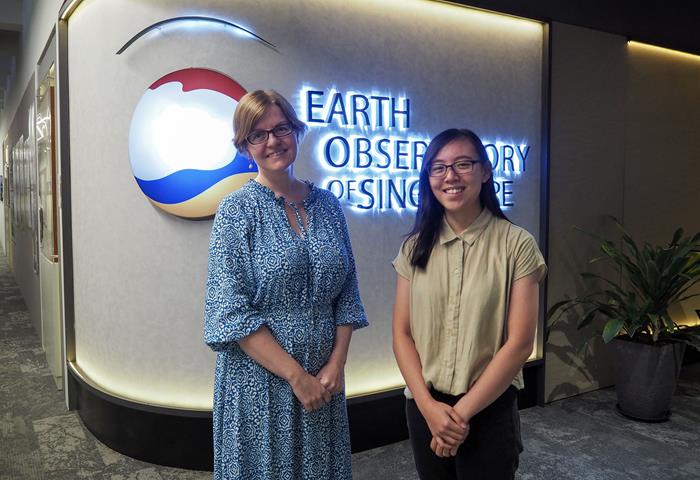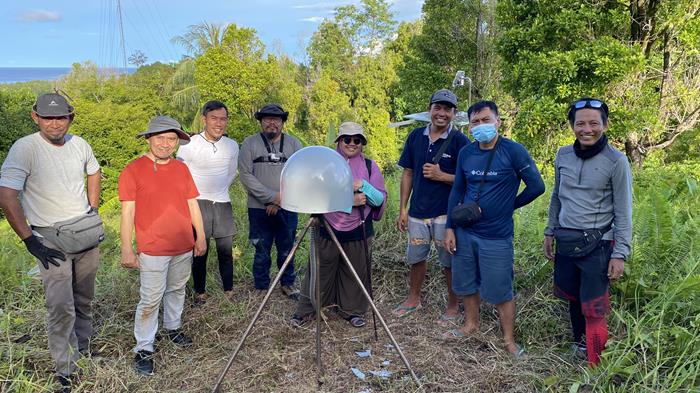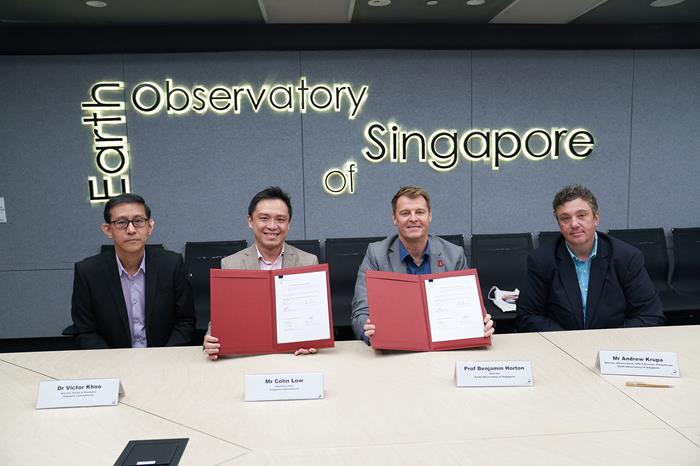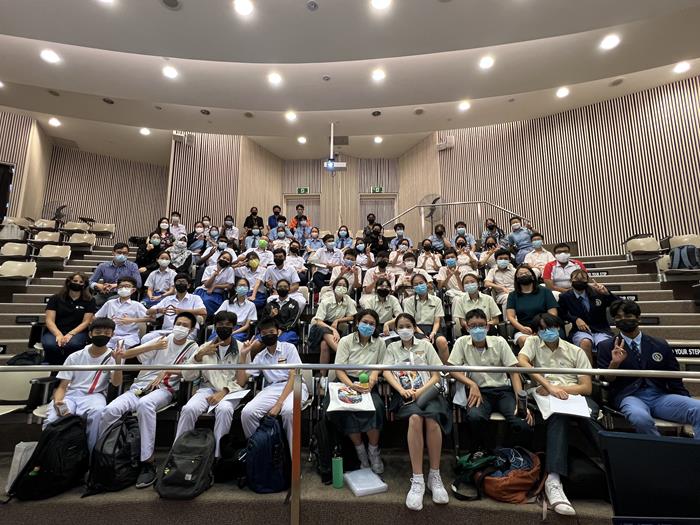2022 has been a successful year for the Earth Observatory of Singapore (EOS). As the Director of EOS, I am extremely proud to highlight some aspects of this success.
Advancing research in geohazard and climate change
While it is true that our research often relates to catastrophes, such as devastating eruptions or coastal flooding, we strive to understand the causes of the problem to supply the solutions needed to make societies safer and more sustainable. We proved this again this year through various publications in top journals. To name a few, Principal Investigator (PI) Benoit Taisne was part of the international team that studied the eruption in Tonga using our very own infrasound stations here in Singapore. And PhD student Cheryl Tay led a study showing that coastal cities in Asia and around the world are sinking, which provides stakeholders with unprecedented data to manage their risk of coastal flooding.

PhD student Cheryl Tay (right) and her supervisor Professor Emma Hill (left) (Source: Phuong Nguyen/Earth Observatory of Singapore)
With the ease of the COVID restrictions, we have resumed our research abroad. Our Centre for Geohazard Observations was the first team to travel overseas, back in April.
They went to Indonesia to take care of the observations stations that help understand tectonic activity in the region.
Since then, other teams have followed to advance many aspects of our research, such as sampling mangrove sediments and analyse microatolls to reconstruct past sea-level changes and understanding changes in the Mekong River and their impacts on local communities.
 The team from the Centre for Geohazard Observations and their collaborators standing next to a GPS station in the Mentawai Islands (Source: Juniator Tulius/Earth Observatory of Singapore))
The team from the Centre for Geohazard Observations and their collaborators standing next to a GPS station in the Mentawai Islands (Source: Juniator Tulius/Earth Observatory of Singapore))
This year also showed the culmination of almost 15 years of excellent research in earthquakes and volcanoes, with the funding of
our first MOE TIER3B proposal called ‘Integrating Volcano and Earthquake Science and Technology (InVEST) in Southeast Asia’. InVEST involves our Tectonics and Volcano teams to reduce the risk and affects from geohazards in Southeast Asia and shows how critical it still is to study these phenomena in Singapore.
Developing partnerships
At EOS, we do not work in silos and constantly look for new collaborations. Through our interdisciplinary research, we aim to be at the cutting-edge of science, but also work with local and regional governmental agencies to enhance the impact of our research.
We co-hosted two major international sea-level conferences last July, which brought together scientists and practitioners so that the most proper solutions can be discussed and brought to the fore. EOS supplied support to early career scientists from Southeast Asia to enable them to attend the conferences in person.
We also signed an agreement with the Singapore Land Authority to share data that will advance our understanding of sea-level rise and tectonic and atmospheric processes.
 Dr Victor Khoo and Mr Colin Low (SLA) with Professor Benjamin Horton and Mr Andrew Krupa (EOS) during the signing of a research agreement to share data. (Source: Nanyang Technological University)
Responding to disasters and celebrating successful mitigation strategies
Dr Victor Khoo and Mr Colin Low (SLA) with Professor Benjamin Horton and Mr Andrew Krupa (EOS) during the signing of a research agreement to share data. (Source: Nanyang Technological University)
Responding to disasters and celebrating successful mitigation strategies
Our EOS Remote Sensing Lab, which celebrated its first anniversary in August, has done a terrific job at producing maps promptly to aid disaster response. These included maps showing the areas that were likely flooded by Typhoon Noru in September, and those that were
likely damaged by the magnitude-5.6 earthquake that struck Indonesia in November.
I am also incredibly proud of the research done by our scientists from the Risk and Society group, which has for example led to the Averted Disaster Award (ADA). ADA is a new award in collaboration with the World Bank to celebrate successful disaster risk mitigation interventions, based on the research by Assistant Professor David Lallemant and his team.
Engaging with communities
We have resumed face-to-face engagement activities, an important side of our community engagement strategy that allows to reach a growing number of curious minds. By installing new
observation stations at the Science Centre Singapore (SCS) and in schools, and by starting
a new competition for students at our Earth Alive exhibition at SCS, we hope to inspire the students to become steward of a sustainable future.
 The Earth Alive Inter-School Challenge brought together twelve teams of students from six secondary schools to compete on Geography-related challenges (Source: Earth Observatory of Singapore)
The Earth Alive Inter-School Challenge brought together twelve teams of students from six secondary schools to compete on Geography-related challenges (Source: Earth Observatory of Singapore)
We also continue to raise awareness and educate a wide range of audiences online. Early this year,
we launched the award-winning Changing Ocean Asia, a documentary that looks at the impacts of climate change on the ocean, and the solutions EOS is working on to mitigate the impacts. By making the science available to the public, we hope to promote a safer and more sustainable future for all.
Looking forward to 2023
As we approach 2023, there are a few things to look forward to. For example, EOS will be celebrating its 15th anniversary, a milestone for which we are preparing a range of activities. Before this, in January, we will hold our annual meeting where PIs, researchers and students will present their latest research.
I wish you all the best for this festive period, and I very much look forward to working and engaging with you next year.